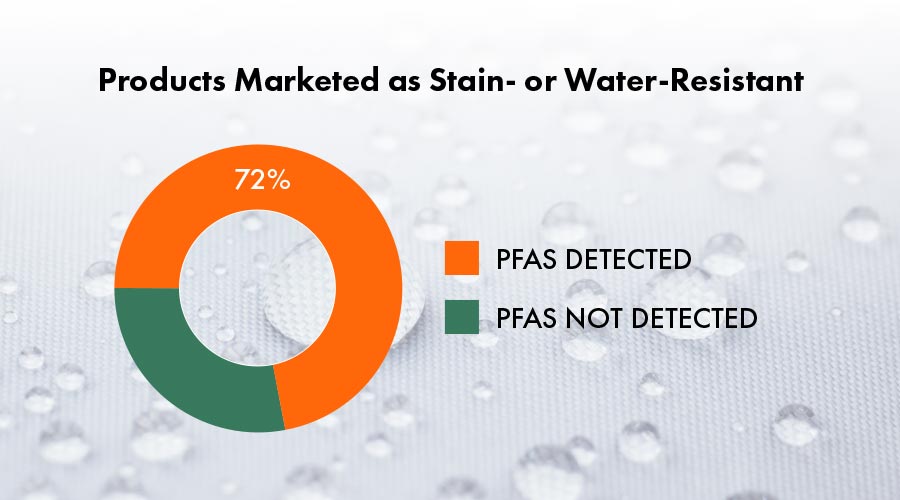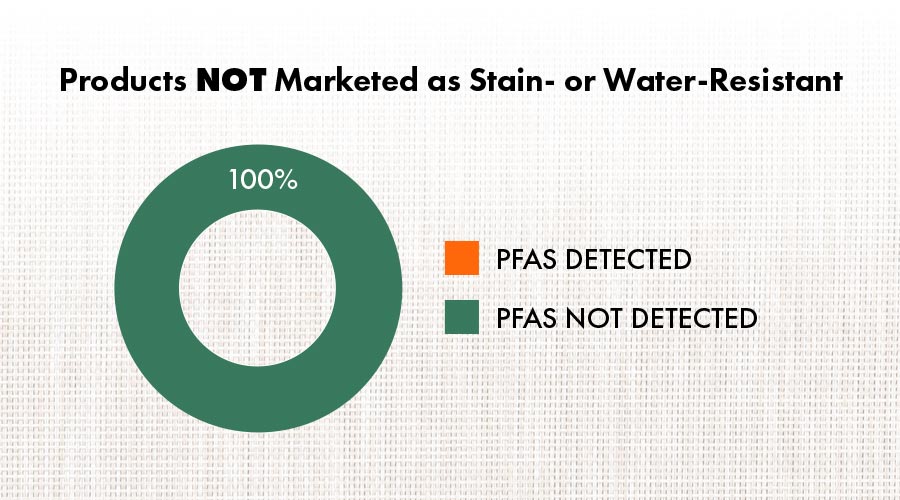Executive Summary
Toxic Convenience: The hidden costs of forever chemicals in stain- and water-resistant products
Executive Summary
For decades, makers of textiles including apparel and home furnishings have turned to the persistent toxic chemicals known as per- and polyfluoroalkyl substances (PFAS) to make their products resist water and stains. But their choice to use these “forever chemicals” has contributed to contamination of drinking water, homes, people, fish, and wildlife with chemicals that can cause cancer, suppress the immune system, increase cholesterol, and lead to other serious health problems.
Even though PFAS are in many of the items we use every day, we know shockingly little about which products contain this harmful chemical class—with almost no product labels disclosing their presence. To uncover this hidden information, we investigated three kinds of commonly used products, purchased from 10 major retailers. We tested for the presence of PFAS in the three categories of products: outdoor apparel, bedding, and tablecloths and napkins. To our knowledge, this testing provides the first brand-specific information on the presence of PFAS in key home furnishings such as mattress pads, comforters, and tablecloths.
We selected 20 items from each of the three categories, choosing mainly items advertised as stain- or water-resistant. We purchased the items from the following retailers: Amazon, Bed Bath & Beyond, Costco, Dick’s Sporting Goods, Kohl’s, Macy’s, REI, Target, TJX, and Walmart. We screened the 60 items for total fluorine, as fluorine may indicate the presence of PFAS, then commissioned PFAS testing of items with fluorine above our screening level. Analysis for total fluorine and PFAS was conducted at independent laboratories.
We found that PFAS are still in wide use in apparel and home furnishings, despite availability of alternatives:
- PFAS are commonly used for stain and water resistance. The majority (72%) of items marketed as stain- or water-resistant contained PFAS. On the other hand, none of the items without stain or water resistance marketing appeared to contain PFAS.
- Multiple types of consumer products contain PFAS. We detected PFAS in a wide variety of products that included rain jackets, hiking pants, shirts, mattress pads, comforters, tablecloths, and napkins.
- No retailer’s product line was totally PFAS-free. At least one product from each of the 10 retailers contained PFAS.
- Manufacturers have been using a mixture of PFAS that includes compounds banned in other countries. Our testing found not just the newer compounds believed to be the most commonly used, but also the older PFAS banned in the European Union and phased out by major U.S. manufacturers. Most PFAS-containing items (74%) tested positive for these older PFAS.
- Alternatives to PFAS for stain and water resistance are in use. We found items in each category that were marketed as stain- and/or water-resistant yet appeared to be free of PFAS-based treatments.


The widespread application of PFAS to textiles bears significant responsibility for a toxic trail of pollution that begins with the manufacture of the chemicals, continues as they are applied to fabric and made into products, enters homes, schools, and workplaces as finished items are sold and used, and ends with widespread contamination of air and water after disposal of the products.
Safer alternatives can be used to prevent the contamination of homes, bodies, wildlife, food, and drinking water with PFAS. Retailers, manufacturers, and state and federal leaders each have a role to play to bring a swift end to this unnecessary use of PFAS.
We recommend the following:
Companies that make home furnishings and apparel should adopt public corporate chemicals policies to phase out PFAS use and move to safer methods, disclose all product ingredients, and keep the public updated on progress.
Retailers should “mind the store” by adopting public corporate chemical policies to ensure all textile products available for sale are free of PFAS and contain only safer substitutes, requiring suppliers to provide full ingredient information, and reporting progress to the public.
State and federal leaders should pass polices to end the use of PFAS in all textiles, establish comprehensive chemicals policies to replace harmful chemicals with safer alternatives, ensure cleanup of contaminated communities, and wield government purchasing power to avoid PFAS.
We can envision a future in which the clothes we wear and all products in our homes, schools, and workplaces are free of toxic chemicals. PFAS—incredibly persistent, and so mobile that they have contaminated drinking water for millions of people—clearly don’t belong. To work towards this future, we need to phase out the “forever chemicals” that jeopardize it.
Acknowledgments
The authors thank those who generously shared their expertise in reviewing this report and provided extremely helpful feedback: Shari Franjevic, Dr. Gillian Miller, Dr. Amina Salamova, and Dr. Ike van der Veen. This study was supported by generous funding from The Bullitt Foundation, Defend Our Health, Forsythia Foundation, The John Merck Fund, The JPB Foundation, New York Community Trust, and Passport Foundation.
Read the Full Report
- I.Executive Summary
- II.Introduction
- III.Methods
- IV.Results
- V.Implications
- VI.Moving Past PFAS
- VII.Recommendations
